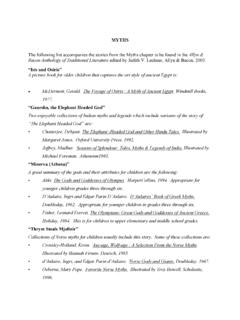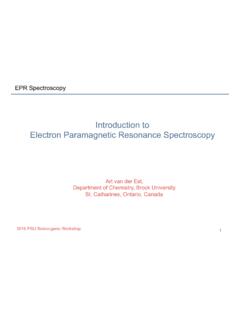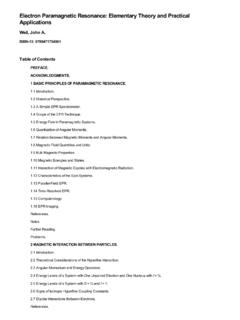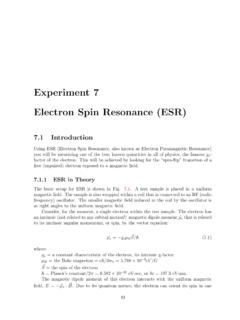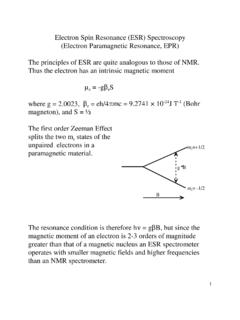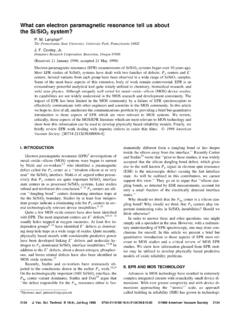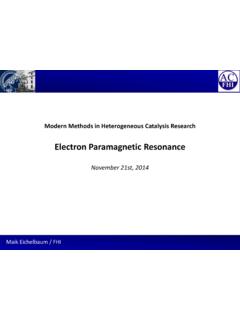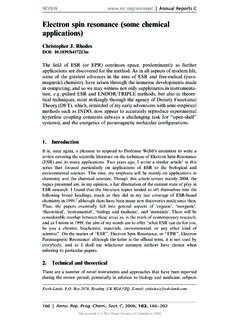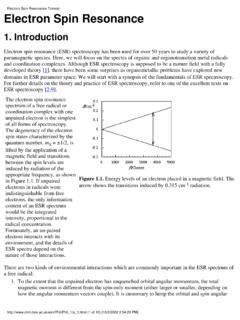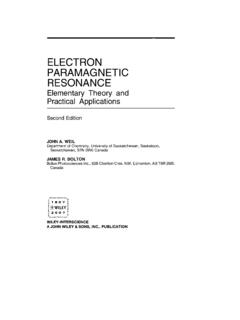Transcription of Electron Paramagnetic Resonance Theory E. Duin
1 1 - 1 Electron Paramagnetic Resonance Theory E. Duin 1 - 2 1. Basic EPR Theory Introduction This course manual will provide the reader with a basic understanding needed to be able to get useful information using the technique of Electron Paramagnetic Resonance (EPR) spectroscopy. EPR spectroscopy is similar to any other technique that depends on the absorption of electromagnetic radiation. A molecule or atom has discrete (or separate) states, each with a corresponding energy. Spectroscopy is the measurement and interpretation of the energy differences between the atomic or molecular states.
2 With knowledge of these energy differences, you gain insight into the identity, structure, and dynamics of the sample under study. We can measure these energy differences, E, because of an important relationship between E and the absorption of electromagnetic radiation. According to Planck's law, electromagnetic radiation will be absorbed if: E = h , (1) where h is Planck's constant and v is the frequency of the radiation. The absorption of energy causes a transition from a lower energy state to a higher energy state. In conventional spectroscopy, is varied or swept and the frequencies at which absorption occurs correspond to the energy differences of the states.
3 (We shall see later that EPR differs slightly.) Typically, the frequencies vary from the megahertz range for NMR (Nuclear Magnetic Resonance ) (AM, FM, and TV transmissions use electromagnetic radiation at these frequencies), through visible light, to ultraviolet light. Radiation in the gigahertz range (GHz) with a wavelength of a few cm (ca. 3 cm) is used for EPR experiments. Such radiation lies far outside the visible region: it is microwave radiation used in ordinary radar equipment and microwave ovens. The Zeeman Effect An isolated Electron , all alone in space without any outside forces, still has an intrinsic angular momentum called "spin".
4 Because an Electron is charged, the angular motion of this charged particle generates a magnetic field. In other words, the Electron due to its charge and angular momentum, acts like a little bar magnet, or magnetic dipole, with a magnetic moment, . Fig. 1: Free, unpaired Electron in space: Electron spin magnetic moment 1 - 3 The energy differences studied in EPR spectroscopy are predominately due to the interaction of unpaired electrons in the sample with a magnetic field produced by a magnet in the laboratory. This effect is called the Zeeman Effect. The magnetic field, B0, produces two energy levels for the magnetic moment, , of the Electron .
5 The unpaired Electron will have a state of lowest energy when the moment of the Electron is aligned with the magnetic field and a stage of highest energy when is aligned against the magnetic field. The two states are labeled by the projection of the Electron spin, ms, on the direction of the magnetic field. Because the Electron is a spin particle, the parallel state is designated as ms = - and the antiparallel state is ms = + (Figs. 2 and 3). The energy of each orientation is the product of and B0. For an Electron = msge , where is a conversion constant called the Bohr magneton and ge is the spectroscopic g-factor of the free Electron and equals ( ).
6 Therefore, the energies for an Electron with ms = + and ms = - are, respectively E1/2 = ge B0 and (2) E-1/2 = - ge B0 (3) As a result there are two energy levels for the Electron in a magnetic field. Fig. 2: Minimum and maximum energy orientations of with respect to the magnetic field B0 Fig. 3: Induction of the spin state energies as a function of the magnetic field B0. 1 - 4 Spin-Orbit Interaction When we take an Electron in space with no outside forces on it and place it on to a molecule, its total angular momentum changes because, in addition to the intrinsic spin angular momentum ( ), it now also possesses some orbital angular momentum ( ).
7 An Electron with orbital angular momentum is in effect a circulating current, and so there is also a magnetic moment arising from the orbital angular momentum. These two magnetic moments interact, and the energy of this spin-orbit interaction depends on their relative orientations. Electron in space (4) Electron in a molecule (5) In general, the orbital angular momentum is approximately zero for an Electron in the ground state (s Electron ). Interaction between the ground state and excited states, however, admixes small amounts of orbital angular momentum to the ground state: spin-orbit coupling contribution.
8 (6) It is common practice to assume that the spin-orbit coupling term is proportional to which means we can simply combine both terms on the right and just change the value of ge to g, or (7) and (8) The magnitude of the spin-orbit coupling contribution depends on the size of the nucleus containing the unpaired Electron . Therefore, organic free radicals, with only H, O, C and N atoms, will have a small contribution from spin-orbit coupling, producing g factors very close to ge while the g factors of much larger elements, such as metals, may be significantly different from ge.
9 A simpler alternative way of thinking about the spin-orbit coupling is that a virtual observer on the Electron would experience the nucleus (nuclei) as an orbiting positive charge producing a second magnetic field, B, at the Electron . (9) Fig. 4 1 - 5 Since only the spectrometer value of B is known we can rewrite this as: (10) The quantity ge + g or g contains the chemical information on the nature of the bond between the Electron and the molecule, the electronic structure of the molecule. The value of g can be taken as a fingerprint of the molecule. g-Factor From the above discussion we can see that one parameter whose value we may wish to know is g.
10 In an EPR spectrometer, a Paramagnetic sample is placed in a large uniform magnetic field which, as shown above, splits the energy levels of the ground state by an amount E where (11) Since is a constant and the magnitude of B0 can be measured, all we have to do to calculate g is determine the value of E, the energy between the two spin levels. This is done by irradiating the sample with microwaves with a set frequency and sweeping the magnetic field (Fig. 5). Fig. 5: The EPR experiment 1 - 6 Absorption of energies will occur when the condition in (11) is satisfied. The value of g can then be calculated from (in GHz) and B0 (in gauss) using, (12) or (h = 10-34 J s; = 10-28 J G-1) (13) Two facts are apparent from equations 2 and 3, equation 11 and the graph in Figure 5.









